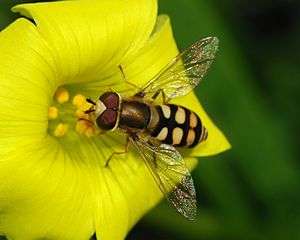Eupeodes corollae
Eupeodes corollae is a very common European species of hoverfly.[1] Adults are 6–11 millimetres (0.24–0.43 in) in body length. Males and females have different marking on the abdomen; males have square commas on tergites 3 and 4, whereas females have narrow commas. Larvae feed on aphids. This species has been used experimentally in glasshouses as a method of aphid control,[2] and to control scale insects and aphids in fruit plantations. They were found to be partial to the fruit, eating more fruit than aphids.[3]
| Eupeodes corollae | |
|---|---|
 | |
| male | |
_female.jpg) | |
| female | |
| Scientific classification | |
| Kingdom: | |
| Phylum: | |
| Class: | |
| Order: | |
| Family: | |
| Subfamily: | |
| Tribe: | |
| Genus: | |
| Subgenus: | Eupeodes |
| Species: | E. corollae |
| Binomial name | |
| Eupeodes corollae (Fabricius, 1794) | |
| Synonyms | |
E. corollae is found across Europe, North Africa and Asia. Adults are often migratory.[4]
Technical Description
External images
For terms see Morphology of Diptera
Wing length 5-8·25 mm. Male abdomen with pre-genital segment very large and conspicuous. Genitalia large. Yellow spots reach the side margin of tergites 3 and 4.Scutellum mainly yellow-haired. Female frons with white dust spots and junction between black ground colour and yellow spots straight.[5]
[6]
[7][8]
Distribution
Palaearctic Range: from Fennoscandia South to Iberia, to the Mediterranean basin. Coastal States of Africa down to South Africa. Ireland East into European Russia, Russian Far East, Siberia, to the Pacific coast and Japan. China, Formosa.[9][10] The male genitalia and the larva are figured described by Dusek & Laska (1961) [11]
Biology
Habitat: grassland, dune systems, dry river beds, garrigue, most sorts of farmland (including arable crops), suburban gardens, orchards, alpine grassland in the Alps. Hedgerows, grassy clearings in woodland, crops, gardens, tracksides, and road verges. Flowers visited include umbellifers, Achillea millefolium, Campanula rapunculoides, Chrysanthemum, Cirsium, Eschscholzia californica, Galeopsis, Hypericum, Leontodon, Origanum vulgare, Potentilla erecta, Ranunculus, Rubus fruticosus, Salix, Senecio, Tripleurospermum inodoratum, Tussilago.[12]
The flight period is May to September (all the year in southern Europe). Information on the biology of Eupeodes corollae is provided by Marcos-Garcia (1981) [13] and Barkemeyer (1994).[14]
References
- Stubbs, Alan E.; Falk, Steven J. (1983). British Hoverflies: An Illustrated Identification Guide. British Entomological & Natural History Society. p. 253, xvpp.
- Santos Rojo; Keith R. Hopper; M. Angeles Marcos-García (2004). "Fitness of the hover flies Episyrphus balteatus and Eupeodes corollae faced with limited larval prey". Journal Entomologia Experimentalis et Applicata. Springer Netherlands. 81 (1): 53–59. doi:10.1007/BF00187838. ISSN 0013-8703.
- Jacopo Rossi; Ursula Gamba; Massimo Pinna; Sandra Spagnolo; Cristina Visentin; Alberto Alma (2006). "Hoverflies in organic apple orchards in north-western Italy" (PDF). Bulletin of Insectology. Bologna: Facolta' Di Agraria Universita' Di Bologna. 59 (2): 111–114. ISSN 1721-8861. Retrieved 8 January 2009.
- Van Veen, M.P. (2004). Hoverflies of Northwest Europe, Identification Keys to the Syrphidae (Hardback). Utrecht: KNNV Publishing. p. 254. ISBN 90-5011-199-8.
- Van Veen, M. (2004) Hoverflies of Northwest Europe: identification keys to the Syrphidae. 256pp. KNNV Publishing, Utrecht.addendum
- Van der Goot,V.S. (1981) De zweefvliegen van Noordwest - Europa en Europees Rusland, in het bijzonder van de Benelux. KNNV, Uitgave no.32: 275pp. Amsterdam.
- Bei-Bienko, G.Y. & Steyskal, G.C. (1988) Keys to the Insects of the European Part of the USSR, Volume V: Diptera and Siphonaptera, Part I. Amerind Publishing Co., New Delhi. ISBN 81-205-0080-6.
- Coe, R.L. (1953) Diptera: Syrphidae. Handbks.ident.Br.insects, 10(1): 1-98. R.ent.Soc.London. pdf
- Fauna Europaea
- Peck, L.V. (1988) Syrphidae. In: Soos, A. & Papp, L. (eds.) Catalogue of Palaearctic Diptera, 8: 11-230. Akad.Kiado, Budapest.
- Dusek, J. & Laska, P. (1961) Beitrag zur Kenntnis der Schwebfliegen-Larven III (Syrphidae, Diptera). Prirod.cas.slezsky, 22: 513-541.
- de Buck, N. (1990) Bloembezoek en bestuivingsecologie van Zweefvliegen (Diptera, Syrphidae) in het bijzonder voor België. Doc.Trav. IRSNB, no.60, 1-167.
- Marcos-García, Mª A. (1981) Contribucion al conocimiento de los Syrphidae (Dipt.) de la zona noreste de la provincia de Salamanca. Bol.Asoc.esp.Entom., 4: 157-171.
- Barkemeyer, W. (1994) Untersuchung zum Vorkommen der Schwebfliegen in Niedersachsen und Bremen (Diptera: Syrphidae). Naturschutz und Landschaftspflege in Niedersachsen, 31: 1-514.